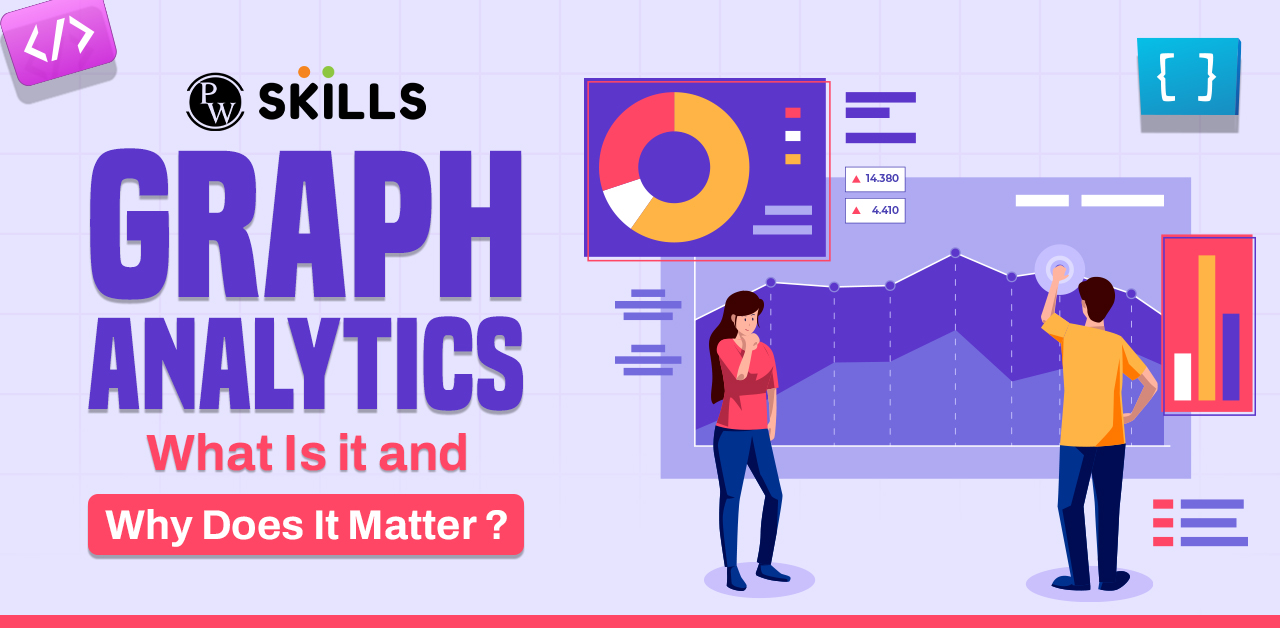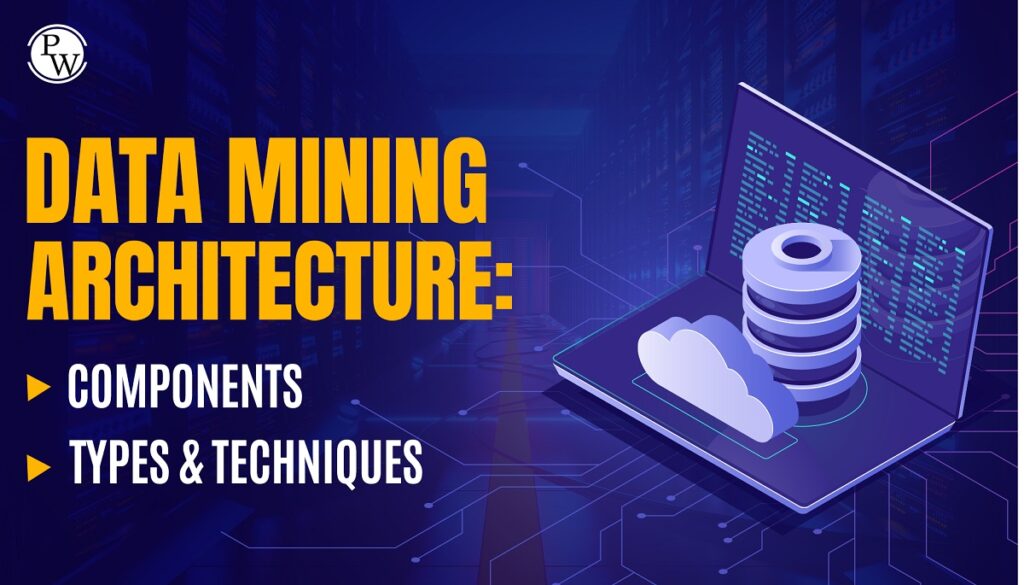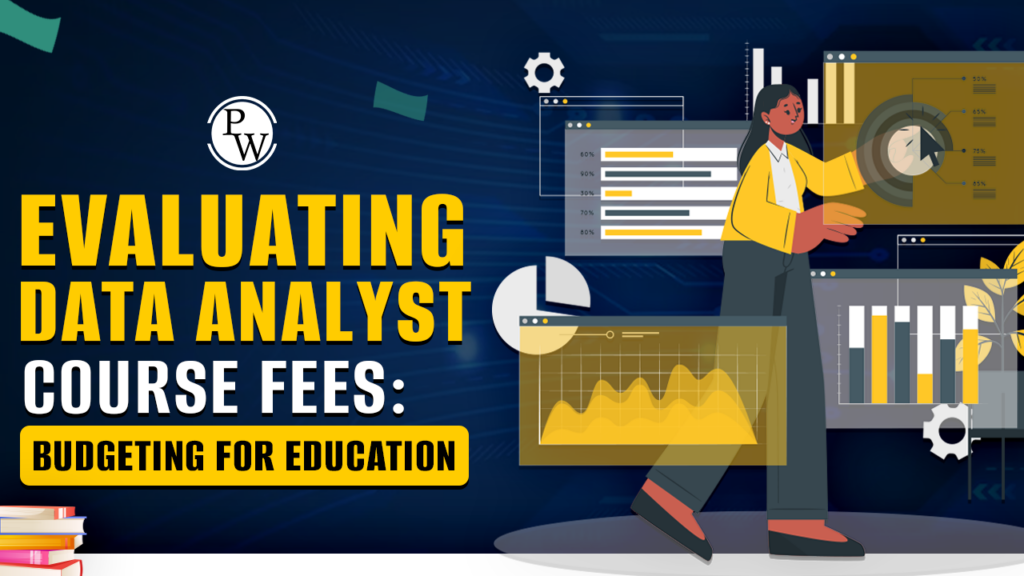Graph analytics is a specialized form of data analysis focused on examining and interpreting graph structures, relationships, and networks within complex datasets! Keep reading to know more!
Graph Analytics: Have you ever wondered how social media platforms can suggest friends or Netflix can provide personalized viewing recommendations? Or how online retailers like Amazon know exactly which products to show you?

The answer comes down to graph analytics – a powerful set of techniques enabling organizations to gain valuable insights from the relationships between data. Graph analytics has emerged as an essential tool for the digital world, helping organizations understand their customers, prevent fraud, improve cybersecurity and much more.
In this blog post, we will break down graph analytics – explaining what it is, how it works and sharing real world examples of how companies are leveraging this approach to gain competitive advantages.
If you want to stay ahead of the game and elevate your skills in graph analytics, look no further than Physics Wallah’s Data Analytics Course. And as a bonus for our readers, use the coupon code “READER” to avail an exclusive discount on the course fee.
What is meant by Graph Analytics?
Graph analytics involves the evaluation of information organized as objects and their connections within a graph structure. The primary aim is to comprehend the relationships between these objects in the graph.
Graph Analytics Examples
Here are some illustrative examples showcasing the application of graph analytics across various domains:
1) Social Media Analysis:
Platforms like Facebook and Twitter utilize graph analytics to understand user behaviors, identify influential users, and recommend connections. By analyzing the relationships between users (nodes) and their interactions (edges), these platforms can enhance user engagement and content recommendation systems.
2) Transportation and Logistics:
Companies like Uber and Lyft employ graph analytics to optimize ride-sharing routes. By evaluating the connectivity between different locations (nodes) and traffic patterns (edges), these services can determine the most efficient routes, minimize travel times, and enhance user satisfaction.
3) Fraud Detection:
Financial institutions utilize graph analytics to detect fraudulent activities. By examining intricate networks of transactions between accounts (nodes) and identifying suspicious patterns or clusters (edges), banks can proactively identify and mitigate fraudulent behavior.
4) Healthcare and Biotechnology:
Graph analytics aids in understanding complex biological systems. For instance, researchers use graphs to represent interactions between proteins, genes, and diseases. By analyzing these interconnected networks, scientists can identify potential drug targets, understand disease pathways, and accelerate drug discovery processes.
5) Cybersecurity:
Organizations leverage graph analytics to enhance their cybersecurity posture. By mapping relationships between devices, users, and activities within a network, security teams can detect anomalies, identify potential threats, and fortify their defense mechanisms against cyber-attacks.
6) Recommendation Systems:
E-commerce platforms like Amazon use graph analytics to enhance product recommendations. By analyzing purchase histories, product views, and user interactions, these platforms can identify similar products, understand user preferences, and deliver personalized recommendations, thereby increasing sales and customer satisfaction.
7) Supply Chain Management:
Companies employ graph analytics to optimize their supply chain networks. By evaluating relationships between suppliers, manufacturers, distributors, and retailers, organizations can identify bottlenecks, streamline operations, reduce costs, and enhance overall efficiency.
Graph analytics offers a versatile toolkit for analyzing complex relationships, patterns, and networks across various sectors, leading to improved decision-making, enhanced efficiency, and innovative solutions.
How Does Graph Analytics Work?
Graph analytics functions by employing specialized algorithms tailored for graph structures, such as clustering, partitioning, breadth-first search, PageRank, and more. These algorithms are instrumental in dissecting and comprehending intricate relationships between various entities within a network. Here’s a breakdown of how graph analytics operates:
1) Clustering:
This involves grouping similar objects together based on shared characteristics. The objective is to maximize similarities within clusters while minimizing similarities between different clusters. Graph analytics employs clustering in diverse fields like machine learning, image processing, data mining, and various scientific disciplines to identify patterns or similarities.
2) Cutting or Partitioning:
The aim here is to identify the optimal division or cut within a graph with minimal edge intersections. Such techniques are vital for pinpointing vulnerabilities in networks, optimizing communication pathways, and detecting communities within social networks.
3) Search Algorithms:
Breadth-first search and depth-first search are fundamental techniques that explore and traverse a graph to uncover specific patterns or relationships. These algorithms are pivotal in tasks ranging from identifying connected components to navigating vast networks efficiently.
4) Shortest and Widest Path Algorithms:
These algorithms determine the most efficient routes between nodes in a graph. Whether it’s finding the quickest route in transportation logistics or optimizing IP traffic routing based on bandwidth, these techniques offer solutions to various optimization challenges.
5) Connected Components:
This approach identifies clusters within a graph where each node connects to every other node within that cluster. It’s an essential tool for analyzing social networks, ensuring seamless communication across networks, and understanding interdependencies.
6) PageRank:
Initially devised for ranking web pages, PageRank assesses the significance or influence of nodes within a graph. Beyond search engine applications, PageRank finds utility in diverse domains such as recommendation systems, ecological network analysis, and understanding protein relationships.
Graph analytics delves deep into network structures using specialized algorithms, enabling analysts to extract meaningful insights, optimize pathways, detect patterns, and make informed decisions across various industries and applications.
Also Read: What is the difference between big data analysis and analytics?
Graph Analytics Tools
Graph analytics tools play a pivotal role in unraveling the intricacies of interconnected data by leveraging graph databases. These tools facilitate the exploration of relationships, patterns, and structures within complex datasets, offering insights across various domains. Here is an in-depth look at some leading graph analytics tools:
1) Amazon Neptune
Overview: Amazon Neptune, a fully-managed graph database service, supports both property graphs and RDF graphs. It is designed for high-performance querying of highly connected data.
Use Cases: Commonly used in recommendation engines, fraud detection, and knowledge graphs.
2) Apache Giraph
Overview: Apache Giraph is an open-source graph processing system built for scalability. It is based on the Bulk Synchronous Parallel (BSP) model, making it suitable for large-scale graph processing.
Use Cases: Often used in social network analysis, web analysis, and biological network analysis.
3) ArangoDB
Overview: ArangoDB is a multi-model database that supports graph, document, and key-value models. It provides a unified platform for diverse data models.
Use Cases: Suitable for applications requiring flexibility in data modeling, such as content management systems and identity management.
4) Cayley
Overview: Cayley is an open-source graph database that supports various backends, including LevelDB and MongoDB. It comes with a powerful query language inspired by the Gremlin language.
Use Cases: Ideal for small to medium-sized projects, Cayley is often employed in knowledge graphs and semantic web applications.
5) DataStax
Overview: DataStax offers a graph database as part of its enterprise data platform. It is built on Apache Cassandra and provides scalability and high availability.
Use Cases: Frequently utilized in applications requiring real-time recommendations, fraud detection, and network analysis.
6) FlockDB
Overview: FlockDB, developed by Twitter, is a distributed graph database that focuses on horizontal scalability. It is designed for real-time queries.
Use Cases: Commonly used in social network applications, where real-time access to relationships is crucial.
7) Neo4j
Overview: Neo4j is a widely adopted graph database known for its native graph processing engine. It supports ACID properties and is suitable for complex graph queries.
Use Cases: Applied in various domains such as fraud detection, recommendation engines, and network management.
8) OrientDB
Overview: OrientDB is a multi-model database that combines graph and document features. It supports ACID transactions and is designed for flexibility.
Use Cases: Ideal for applications that require support for multiple data models, such as content management systems and real-time analytics.
Graph Analytics Use Cases
Here are some specific use cases that highlight the application and importance of graph analytics across various industries and domains:
1) Social Network Analysis:
Platforms like Facebook, LinkedIn, and Twitter utilize graph analytics to understand user connections, detect communities, and enhance user engagement. By analyzing the relationships between users and their interactions, these platforms can provide personalized content, recommendations, and advertisements to users.
2) Recommendation Systems:
Companies such as Amazon and Netflix employ graph analytics to improve their recommendation algorithms. By examining user preferences, product interactions, and content similarities, these platforms can deliver personalized product suggestions, movie recommendations, and content discovery to users, thereby enhancing customer satisfaction and sales.
3) Fraud Detection:
Financial institutions utilize graph analytics to detect and prevent fraudulent activities. By analyzing complex networks of transactions, account relationships, and user behaviors, banks can identify suspicious patterns, detect fraudulent activities, and mitigate risks, safeguarding customers and preserving financial integrity.
4) Healthcare and Life Sciences:
Researchers in the healthcare and biotechnology sectors leverage graph analytics to understand complex biological systems. By examining interactions between genes, proteins, diseases, and medications, scientists can identify disease pathways, discover potential drug targets, and accelerate drug development processes, leading to improved treatments and patient outcomes.
5) Cybersecurity:
Organizations employ graph analytics to enhance their cybersecurity defenses. By analyzing relationships between devices, users, applications, and network traffic, security teams can detect anomalies, identify potential threats, and respond proactively to cyber-attacks, safeguarding critical assets and data.
6) Supply Chain Optimization:
Companies in the manufacturing, retail, and logistics sectors utilize graph analytics to optimize their supply chain networks. By analyzing relationships between suppliers, manufacturers, distributors, and retailers, organizations can identify bottlenecks, streamline operations, reduce costs, and enhance overall efficiency, ensuring timely delivery and customer satisfaction.
7) Transportation and Logistics:
Companies like Uber and Lyft leverage graph analytics to optimize their ride-sharing and delivery services. By analyzing the connectivity between drivers, passengers, destinations, and traffic patterns, these platforms can determine the most efficient routes, minimize travel times, and enhance user experiences, leading to increased operational efficiency and customer satisfaction.
Graph analytics offers a powerful framework for analyzing complex relationships, patterns, and networks across diverse industries and applications, enabling organizations to derive valuable insights, make informed decisions, and drive innovation.
Also Read: What Is Big Data Analytics? Definition, Benefits, and More
Types of Graph Analytics
Graph analytics provides a specialized lens through which intricate relationships, structures, and patterns in data can be examined. Let’s delve deeper into the specific types of graph analytics techniques that facilitate this intricate examination:
1) Path Analysis:
At its core, path analysis in graph analytics zeroes in on determining the most efficient or shortest route between two distinct nodes within a given network. This is pivotal in realms such as network routing, transportation logistics, and even in scenarios where optimal navigation between interconnected systems is essential for efficiency and cost-effectiveness.
2) Community Detection:
A pivotal aspect of graph analytics is community detection, which focuses on identifying distinct clusters or communities within a graph where the constituent nodes exhibit analogous attributes or properties. This technique is instrumental in social network analysis, where it aids in discerning groups of individuals with shared interests or affiliations, facilitating targeted engagement and analysis.
3) Centrality Measures:
Graph analytics also encompasses centrality measures, which ascertain the significance or prominence of individual nodes within a network. Through metrics like degree centrality, betweenness centrality, and closeness centrality, organizations can pinpoint nodes that exert considerable influence or serve as crucial connectors within intricate networks, aiding in strategic decision-making and resource allocation.
4) Graph Matching:
Another salient facet of graph analytics is graph matching, which involves juxtaposing two disparate graphs to unearth resemblances, analogous patterns, or shared characteristics. This technique is invaluable in domains such as pattern recognition, where discerning similarities between complex structures or datasets is paramount for deriving meaningful insights and facilitating informed actions.
5) Network Flow Analysis:
Integral to graph analytics is network flow analysis, which scrutinizes the propagation, dissemination, or allocation of information, resources, or entities within a network. By evaluating the dynamics of flow within interconnected systems, organizations can optimize network efficiency, enhance operational performance, and preemptively address bottlenecks or inefficiencies that may impede seamless operations.
Benefits of Using Graph Analytics
Graph analytics offers numerous benefits across various industries and domains due to its ability to analyze complex relationships, patterns, and networks. Here are some key benefits of using graph analytics:
- Graph analytics enables organizations to gain deeper insights into complex relationships, connections, and interactions within their data. By visualizing and analyzing relationships between entities such as customers, products, transactions, and events, organizations can uncover hidden patterns, trends, and anomalies that may not be apparent through traditional data analysis methods.
- By leveraging graph analytics, organizations can make more informed and data-driven decisions. Whether it’s optimizing supply chain networks, enhancing cybersecurity defenses, or improving customer engagement strategies, graph analytics provides valuable insights and recommendations that enable organizations to optimize operations, mitigate risks, and seize new opportunities.
- Graph analytics enables organizations to better understand and anticipate customer needs, preferences, and behaviors. By analyzing customer interactions, relationships, and sentiments across various touchpoints, organizations can personalize marketing campaigns, tailor product recommendations, and enhance customer engagement, thereby improving customer satisfaction and loyalty.
- Graph analytics helps organizations identify and address inefficiencies, bottlenecks, and constraints within their networks and processes. Whether it’s streamlining manufacturing operations, optimizing transportation routes, or improving supply chain logistics, graph analytics provides actionable insights and recommendations that enable organizations to enhance operational efficiency, reduce costs, and improve productivity.
- In industries such as finance, healthcare, and eCommerce, graph analytics helps organizations detect and prevent fraudulent activities. By analyzing complex networks of transactions, interactions, and behaviors, organizations can identify suspicious patterns, anomalies, and activities that may indicate fraudulent behavior, enabling them to mitigate risks, safeguard assets, and protect customers.
- In sectors such as healthcare, life sciences, and research, graph analytics accelerates innovation and discovery by enabling researchers to analyze complex biological systems, relationships, and interactions. By uncovering insights into disease pathways, drug interactions, and genetic relationships, scientists and researchers can develop new treatments, therapies, and solutions that improve patient outcomes and advance scientific knowledge.
- Graph analytics platforms and tools are designed to handle and analyze large volumes of data, making them scalable and flexible solutions for organizations of all sizes. Whether it’s processing billions of transactions, analyzing vast networks of connections, or visualizing complex relationships, graph analytics provides the scalability and flexibility organizations need to adapt to evolving data requirements and challenges.
Graph analytics offers a powerful and versatile framework for analyzing complex relationships, patterns, and networks across diverse industries and applications. By leveraging graph analytics, organizations can enhance insights, improve decision-making, optimize operations, detect fraud, accelerate innovation, and achieve competitive advantages in today’s data-driven world.
Also Read: Data Analysis Techniques in Research: Methods, Tools, Examples
Graph Analytics Courses
Graph analytics is a crucial tool in the world of data analysis. This powerful technique allows us to uncover meaningful insights and patterns from complex networks and relationships within our data. With its growing importance in various industries such as finance, healthcare, and marketing, it is evident that graph analytics is here to stay.
Whether you are a beginner or an experienced analyst, incorporating graph analytics into your skillset will greatly benefit your career. And if you are looking for the perfect course to learn this valuable skill, look no further than Physics Wallah’s Data Analytics Course.
Offering comprehensive lessons and hands-on experience with real-world datasets, this course will equip you with all the necessary knowledge to excel in the field of graph analytics.
And just for being a reader of this blog post, make sure to use the coupon code “READER” at checkout for a special discount. So don’t wait any longer, join the thousands of successful data analysts who have taken this course and take your career to new heights with graph analytics today!
Graph Analyzer
A graph analyzer refers to a specialized tool or software application designed to facilitate the examination, evaluation, and interpretation of graph structures and relationships within complex datasets. By leveraging advanced algorithms, methodologies, and visualization techniques, Graph Analyzers empower users to dissect intricate networks, identify patterns, discern connections, and extract meaningful insights from interconnected data entities.
Applications of Graph Analyzers:
- Social Network Analysis: Graph Analyzers empower researchers, analysts, and organizations to analyze social networks, discern community structures, identify influential nodes, and explore information propagation dynamics within online platforms, fostering insights into human interactions, behaviors, and affiliations.
- Transportation and Logistics: In the realm of transportation and logistics, Graph Analyzers facilitate route optimization, network design, traffic analysis, and supply chain management. By analyzing transportation networks’ complexities, stakeholders can enhance operational efficiency, mitigate congestion, and optimize resource allocation.
- Cybersecurity: Graph Analyzers play a pivotal role in cybersecurity, enabling analysts to detect network intrusions, identify malicious activities, uncover attack vectors, and fortify network defenses. By analyzing interconnected systems and anomalous patterns, organizations can preemptively address vulnerabilities, safeguard critical assets, and mitigate cybersecurity risks.
Biology and Healthcare: Within the domains of biology and healthcare, Graph Analyzers facilitate the analysis of biological networks, gene interactions, protein structures, and disease pathways. By examining intricate biological relationships and structures, researchers can elucidate molecular mechanisms, identify therapeutic targets, and advance scientific understanding of complex biological systems.
For Latest Tech Related Information, Join Our Official Free Telegram Group : PW Skills Telegram Group
Graph Analytics FAQs
What is an analysis of a graph?
Analysis of a graph involves examining and interpreting the relationships, structures, and patterns within interconnected data entities represented as nodes and edges.
Who uses graph analytics?
Various professionals and industries utilize graph analytics, including data scientists, researchers, cybersecurity experts, transportation planners, social media analysts, healthcare professionals, financial institutions, and marketing strategists.
What are the different types of graph analytic algorithms?
The different types of graph analytic algorithms include:
Path Analysis
Community Detection
Centrality Measures
Graph Matching
Network Flow Analysis
How does Graph Analytics differ from traditional data analytics?
While traditional data analytics focuses on structured data and relational databases, graph analytics emphasizes examining and interpreting graph structures, relationships, and interconnected data entities.
What are some common applications of Graph Analytics?
Common applications of graph analytics encompass social network analysis (examining human interactions and affiliations), transportation and logistics optimization (route planning, traffic analysis), cybersecurity (detecting network intrusions, identifying attack vectors), biology and healthcare (analyzing gene interactions, disease pathways), recommendation systems, fraud detection, and more.




